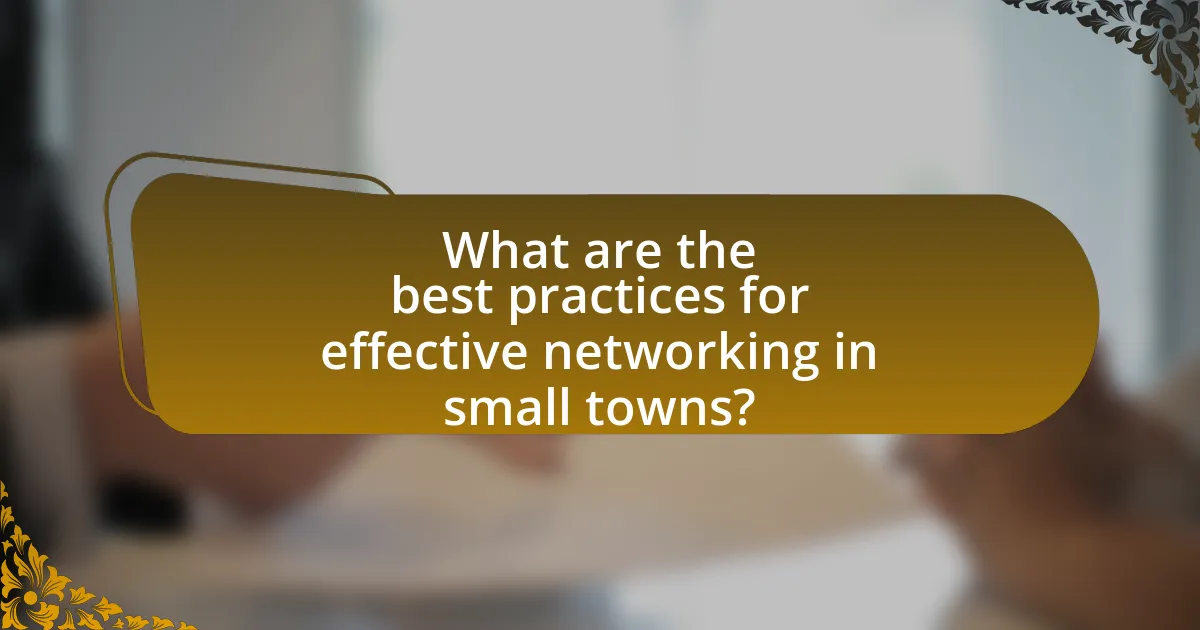Building a strong online presence is essential for local networking success, as it establishes a recognizable digital footprint that connects individuals and businesses within a specific geographic area. Key elements include maintaining active social media profiles, optimizing websites for local search visibility, and engaging in community discussions. A positive online reputation significantly influences consumer trust, with studies showing that a majority of consumers rely on online reviews as much as personal recommendations. The article explores strategies for enhancing online presence, the impact of local relevance, and best practices for optimizing local business websites, ultimately emphasizing the importance of digital engagement in fostering local connections and driving business growth.

What does it mean to build a strong online presence for local networking success?
Building a strong online presence for local networking success means establishing a recognizable and engaging digital footprint that connects individuals and businesses within a specific geographic area. This involves creating and maintaining profiles on social media platforms, optimizing a website for local search engine visibility, and actively participating in online community discussions. Research indicates that 78% of consumers trust online reviews as much as personal recommendations, highlighting the importance of a positive online reputation in local networking. Furthermore, businesses with a well-optimized Google My Business listing can increase their chances of being found by local customers, as 46% of all Google searches are seeking local information. Thus, a strong online presence not only enhances visibility but also fosters trust and engagement within the local community.
How can an online presence enhance local networking opportunities?
An online presence enhances local networking opportunities by increasing visibility and accessibility to local contacts and resources. When individuals or businesses maintain an active online profile, such as on social media platforms or professional networking sites, they can connect with local professionals, organizations, and events more easily. According to a survey by LinkedIn, 70% of professionals reported that they found new networking opportunities through online platforms, demonstrating the effectiveness of digital engagement in fostering local connections.
What are the key elements of an effective online presence?
The key elements of an effective online presence include a professional website, active social media engagement, search engine optimization (SEO), and consistent branding. A professional website serves as the central hub for information and services, enhancing credibility and user experience. Active social media engagement fosters community interaction and brand visibility, with platforms like Facebook and Instagram reporting that 54% of users use social media to research products. Search engine optimization ensures that the website ranks well in search results, increasing organic traffic; studies show that 75% of users never scroll past the first page of search results. Consistent branding across all platforms reinforces recognition and trust, as consistent presentation increases brand awareness by up to 80%.
How does local relevance impact online presence?
Local relevance significantly enhances online presence by improving visibility in search engine results for geographically targeted queries. When businesses optimize their online content for local keywords, they increase the likelihood of appearing in local search results, which is crucial since 46% of all Google searches are seeking local information. This optimization includes using location-based keywords, creating local business listings, and engaging with community-focused content, all of which contribute to higher rankings in local search results. Furthermore, studies show that 78% of mobile local searches result in an offline purchase, underscoring the importance of local relevance in driving foot traffic and conversions.
Why is a strong online presence crucial for local businesses?
A strong online presence is crucial for local businesses because it enhances visibility and accessibility to potential customers. In today’s digital age, 97% of consumers search online for local services, making it essential for businesses to be easily found through search engines and social media platforms. Furthermore, a robust online presence allows local businesses to engage with their community, build brand loyalty, and showcase customer reviews, which influence purchasing decisions. Studies show that 84% of consumers trust online reviews as much as personal recommendations, highlighting the importance of maintaining a positive digital reputation.
What role does online visibility play in attracting local customers?
Online visibility is crucial for attracting local customers as it enhances a business’s discoverability in local search results. When a business appears prominently in online searches, particularly on platforms like Google Maps and local directories, it increases the likelihood of being found by potential customers in the vicinity. According to a study by Google, 76% of people who search for something nearby visit a business within a day, highlighting the direct correlation between online visibility and foot traffic. Furthermore, businesses with optimized online profiles, including accurate information and customer reviews, are more likely to gain trust and engagement from local consumers, ultimately driving sales and fostering community relationships.
How can online reputation influence local networking success?
Online reputation significantly influences local networking success by shaping perceptions and trust among potential connections. A positive online reputation, characterized by favorable reviews, professional social media profiles, and active engagement in local community discussions, enhances credibility and attracts networking opportunities. For instance, a study by BrightLocal in 2022 found that 87% of consumers read online reviews for local businesses, indicating that a strong online presence can lead to increased referrals and partnerships. Thus, maintaining a positive online reputation is crucial for individuals and businesses aiming to succeed in local networking.

What strategies can be employed to build a strong online presence?
To build a strong online presence, individuals and businesses should focus on creating high-quality content, engaging with their audience on social media, optimizing their website for search engines, and utilizing email marketing. High-quality content, such as blog posts and videos, establishes authority and attracts visitors; for instance, companies that regularly publish blog content receive 97% more links to their websites. Engaging on social media platforms fosters community and brand loyalty, with 54% of social media users using these platforms to research products. Search engine optimization (SEO) enhances visibility, as 75% of users never scroll past the first page of search results. Lastly, email marketing remains effective, with a return on investment of $42 for every dollar spent, making it a powerful tool for maintaining customer relationships.
How can social media be leveraged for local networking?
Social media can be leveraged for local networking by creating targeted community groups and engaging with local content. Platforms like Facebook and LinkedIn allow users to join or create groups focused on specific geographic areas or interests, facilitating connections among local professionals and residents. Engaging with local events, sharing relevant news, and participating in discussions can enhance visibility and foster relationships. According to a study by the Pew Research Center, 70% of adults use social media to connect with others, highlighting its effectiveness in building local networks.
What platforms are most effective for local engagement?
Social media platforms such as Facebook, Instagram, and Nextdoor are most effective for local engagement. Facebook allows businesses to create local pages and events, facilitating community interaction, with over 2.8 billion monthly active users, making it a powerful tool for reaching local audiences. Instagram, with its visual focus, enables businesses to showcase local products and services, attracting local customers through targeted hashtags and location tags. Nextdoor specifically caters to neighborhoods, fostering hyper-local connections and recommendations among residents, which enhances community engagement. These platforms collectively provide diverse avenues for businesses to connect with local audiences effectively.
How can content creation enhance social media presence?
Content creation enhances social media presence by providing valuable, engaging, and shareable material that attracts and retains audience attention. High-quality content, such as informative articles, eye-catching visuals, and interactive posts, encourages user interaction, leading to increased visibility and reach. According to a study by HubSpot, companies that prioritize blogging are 13 times more likely to achieve a positive return on investment, demonstrating the effectiveness of consistent content creation in boosting social media engagement and presence.
What are the best practices for optimizing a local business website?
The best practices for optimizing a local business website include ensuring accurate and consistent NAP (Name, Address, Phone Number) information, utilizing local keywords, and optimizing for mobile devices. Accurate NAP information helps search engines and customers find the business easily, while local keywords improve visibility in search results relevant to the local area. Mobile optimization is crucial as over 50% of local searches are conducted on mobile devices, according to Google. Additionally, creating and optimizing a Google My Business profile enhances local search presence and allows for customer engagement through reviews and posts. Implementing these practices can significantly improve a local business’s online visibility and customer reach.
How can SEO improve local search visibility?
SEO can improve local search visibility by optimizing a business’s online presence to rank higher in local search results. This involves using location-specific keywords, creating and optimizing Google My Business listings, and ensuring consistent NAP (Name, Address, Phone number) information across online directories. According to a study by Moz, 46% of all Google searches are seeking local information, highlighting the importance of local SEO strategies in attracting nearby customers. By implementing these tactics, businesses can enhance their visibility to local consumers actively searching for their products or services.
What elements should be included on a local business website?
A local business website should include essential elements such as a clear business name, contact information, location details, service descriptions, customer testimonials, and a blog or news section. These components enhance user experience and improve search engine optimization (SEO). For instance, having accurate contact information and location helps customers find the business easily, while service descriptions inform potential clients about offerings. Customer testimonials build trust, and a blog can engage visitors and improve search rankings. According to a study by BrightLocal, 97% of consumers read online reviews for local businesses, highlighting the importance of including testimonials.

What tools and resources are available for enhancing online presence?
To enhance online presence, businesses and individuals can utilize tools such as social media platforms, search engine optimization (SEO) tools, content management systems (CMS), and analytics software. Social media platforms like Facebook, Instagram, and LinkedIn allow for direct engagement with audiences, while SEO tools such as Google Analytics and SEMrush help optimize website visibility in search engines. Content management systems like WordPress enable easy website creation and management, and analytics software provides insights into user behavior and engagement metrics. These resources collectively contribute to a stronger online presence by improving visibility, engagement, and overall digital strategy effectiveness.
How can analytics tools help in measuring online presence effectiveness?
Analytics tools help in measuring online presence effectiveness by providing data on user engagement, traffic sources, and audience demographics. These tools track metrics such as website visits, social media interactions, and conversion rates, allowing businesses to assess which strategies are successful. For instance, Google Analytics reports that businesses using data-driven decision-making see a 5-6% increase in productivity. By analyzing this data, organizations can refine their online strategies, optimize content, and enhance user experience, ultimately leading to improved online visibility and networking success.
What metrics should be tracked for local networking success?
To measure local networking success, key metrics include the number of connections made, engagement levels, referral rates, and conversion rates. Tracking the number of connections made provides insight into the growth of your network, while engagement levels, such as interactions on social media or attendance at local events, indicate the strength of those connections. Referral rates show how often your network is recommending your services or products, which is crucial for local business growth. Lastly, conversion rates reflect how many of those referrals or connections lead to actual business opportunities, demonstrating the effectiveness of your networking efforts.
How can feedback tools improve online reputation?
Feedback tools can improve online reputation by enabling businesses to gather, analyze, and respond to customer opinions effectively. These tools facilitate real-time feedback collection, allowing companies to identify strengths and weaknesses in their services or products. For instance, a study by BrightLocal found that 91% of consumers read online reviews, and 84% trust them as much as personal recommendations. By actively managing feedback through these tools, businesses can enhance customer satisfaction, address negative comments promptly, and showcase positive experiences, ultimately leading to a stronger online reputation.
What are common challenges faced when building an online presence?
Common challenges faced when building an online presence include establishing brand identity, generating consistent content, and engaging the target audience. Establishing brand identity is crucial as it differentiates a business in a crowded digital space; according to a 2021 survey by HubSpot, 70% of consumers prefer to buy from brands they recognize. Generating consistent content is essential for maintaining visibility and relevance; research indicates that businesses that blog regularly receive 97% more links to their websites. Engaging the target audience can be difficult due to varying preferences and behaviors across platforms, with studies showing that 80% of consumers are more likely to engage with brands that personalize their content.
How can businesses overcome negative online reviews?
Businesses can overcome negative online reviews by actively engaging with customers, addressing their concerns, and demonstrating a commitment to improvement. Responding promptly and professionally to negative feedback shows that the business values customer input and is willing to make changes. According to a study by Harvard Business Review, businesses that respond to reviews can increase customer retention by up to 30%. Additionally, encouraging satisfied customers to leave positive reviews can help balance the overall rating and improve the business’s online reputation.
What strategies can be used to maintain consistency across platforms?
To maintain consistency across platforms, organizations should implement a unified branding strategy that includes standardized messaging, visuals, and tone. This approach ensures that all communications reflect the same identity, which is crucial for building trust and recognition among audiences. For instance, using the same logo, color scheme, and key messages across social media, websites, and email marketing reinforces brand identity. Research by the Content Marketing Institute indicates that consistent branding can increase revenue by up to 23%, highlighting the importance of a cohesive strategy in achieving business objectives.
What practical tips can help in building a strong online presence for local networking?
To build a strong online presence for local networking, individuals should focus on optimizing their social media profiles, engaging with local community groups, and consistently sharing relevant content. Optimizing social media profiles involves using clear, professional photos, complete bios, and location tags to enhance visibility. Engaging with local community groups on platforms like Facebook or LinkedIn fosters connections and increases local visibility. Consistently sharing relevant content, such as local events or industry insights, positions individuals as knowledgeable resources within their community. According to a 2021 survey by the Pew Research Center, 69% of adults in the U.S. use social media, highlighting its importance in local networking efforts.





































